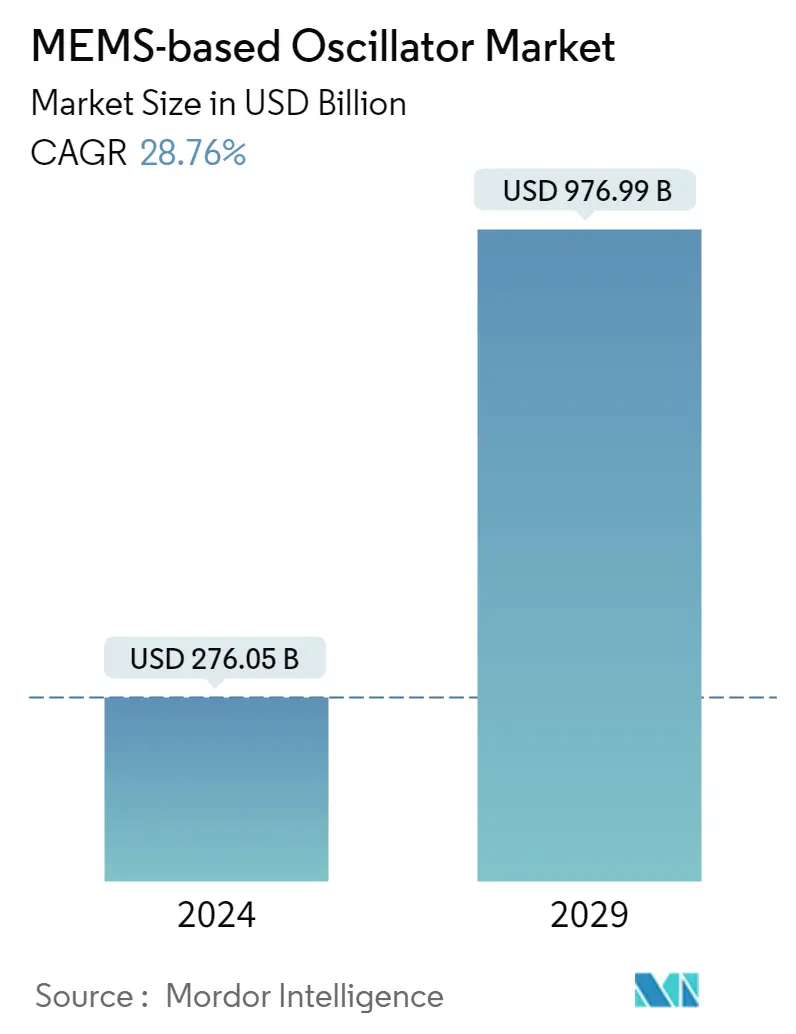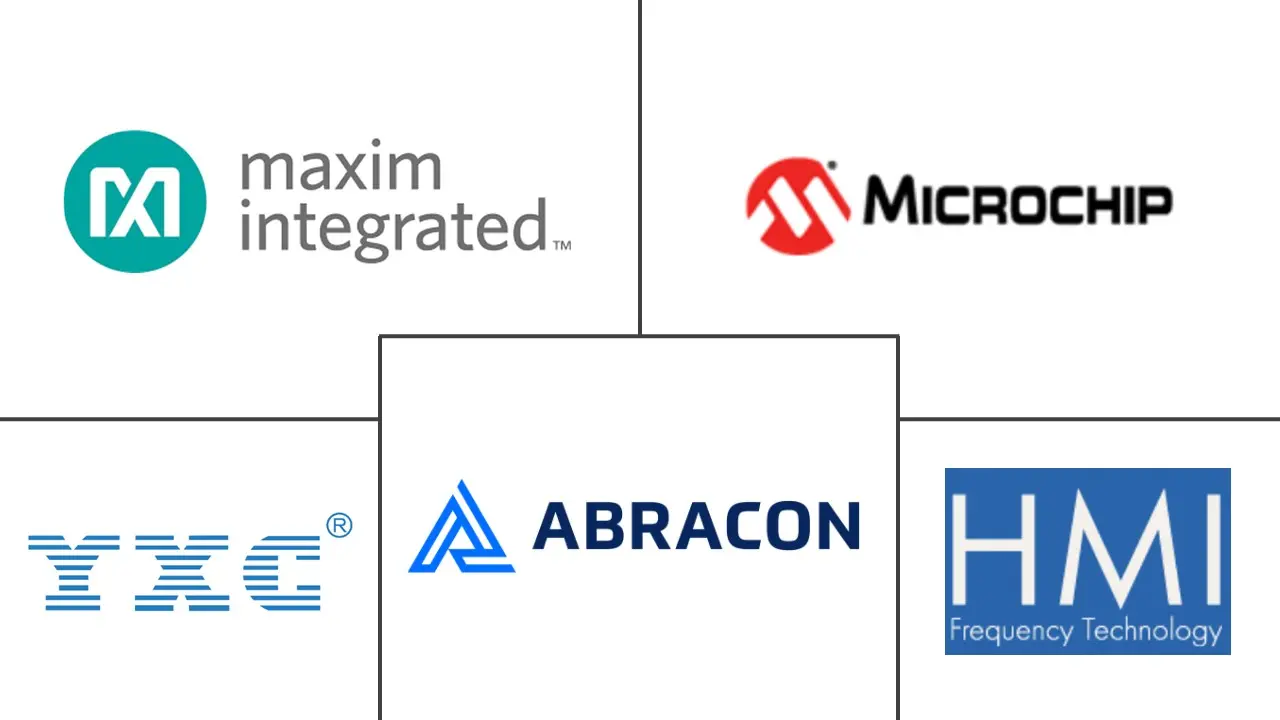Market Size of MEMS-based Oscillator Industry

| Study Period | 2019 - 2029 |
| Market Size (2024) | USD 276.05 Billion |
| Market Size (2029) | USD 976.99 Billion |
| CAGR (2024 - 2029) | 28.76 % |
| Fastest Growing Market | Asia-Pacific |
| Largest Market | Asia-Pacific |
Major Players
*Disclaimer: Major Players sorted in no particular order |
MEMS-Based Oscillator Market Analysis
The MEMS-based Oscillator Market size is estimated at USD 276.05 billion in 2024, and is expected to reach USD 976.99 billion by 2029, growing at a CAGR of 28.76% during the forecast period (2024-2029).
The MEMS oscillator market is accelerated due to increased demand for products from end-use industries worldwide.
- MEMS oscillators are a class of timing apparatus that help create extremely stable reference frequencies that can measure moments. In order to manage information exchange, assess the timing, describe radio frequencies, and place orders for electronic devices, these comparison frequencies are frequently used.
- MEMS and silicon-based technologies also operate over a broad frequency range, are less sensitive to frequency jumps, and are highly resistant to mechanical shock, vibration, and temperature changes. As a result, this technology has been helpful for developing small-sized timing solutions that are also robust, high-performing, and programmable.
- For instance, the silicon MEMS-based oscillator DSC1001 from Microchip offers a broad range of supply voltages and temperatures, including 1MHz to 150MHz with supply voltages between 1.8 and 3.3 VDC and temperature ranges up to -40C to 105C. The device offers jitter and stability performance as low as 10ppm.
- The high R&D costs involved in the development of MEMS oscillator is poised to limit the number of companies operating in the market, which may lead to fewer developments of MEMS oscillators. The established players in the market put significant R&D efforts into designing and developing next-generation silicon timing systems solutions.
- The COVID-19 outbreak had a significant impact on the production of frequency control devices, causing delays in the shipping of finished goods across the automotive, consumer electronics, and aerospace industries. Due to the closure of well-known semiconductor factories, the supply chain was severely harmed. However, as microfluidics and pressure are connected to COVID-19, including respiratory diagnostics and other research tools to study COVID-19 patient monitoring, MEMS-based oscillator devices for medical monitoring applications have benefited.
MEMS-Based Oscillator Industry Segmentation
MEMS-based oscillators are an integral part of every circuit implemented in the industry, and emit highly stable frequencies that can measure time. These reference frequencies may be used to sequence electronic systems, manage data transfer, define radio frequencies, and measure elapsed time. Quartz crystal-based oscillators have been the conventional choice for a wide range of applications in the industry. However, the emergence of MEMS-based silicon oscillators' commercial applications in the last decade has transformed the oscillator market.
The study includes market size estimations by considering the revenues accrued from the sales of MEMS-based oscillators as well as tracking the demand across several end-user industries, such as automotive, aerospace and defense, consumer electronics, IT, and telecom, in various geographies. All data presented in the study is as per the most recent information, and all market projections are adjusted to reflect the impact of COVID-19 on the MEMS-based oscillator market. The market sizes and forecasts are provided in terms of value (USD million) for all the segments.
| By Type | |
| Temperature Compensated Oscillator (TCXO) | |
| Spread Spectrum Oscillator (SSXO) | |
| Voltage Control Oscillator (VCXO) | |
| Digitally Controlled Oscillator (DCXO) | |
| Other Types |
| By End-user Industry | |
| Automotive | |
| Aerospace and Defense | |
| Consumer Electronics | |
| IT and Telecom | |
| Other End-user Industries |
| By Geography | |
| North America | |
| Europe | |
| Asia-Pacific | |
| Rest of the World |
MEMS-based Oscillator Market Size Summary
The MEMS oscillators market is poised for significant growth, driven by the increasing demand for high-performance timing solutions across various end-use industries. These oscillators, known for their stability and robustness, are integral in applications requiring precise frequency generation, such as in consumer electronics, automotive, and aerospace sectors. The technology's ability to operate over a wide frequency range and its resistance to environmental factors like shock and temperature changes make it ideal for portable and wearable devices. Despite the high research and development costs limiting market entry for new players, established companies are heavily investing in next-generation solutions to maintain a competitive edge. The market's expansion is further supported by the rising trend of miniaturization in electronic devices and the growing adoption of 5G technology, which demands compact and efficient timing systems.
Regionally, the Asia-Pacific is emerging as a key market due to the burgeoning demand for wearable technology and the availability of cost-effective manufacturing resources. Countries like China, Japan, India, and South Korea are at the forefront, with companies in the region capitalizing on the trend towards tech-savvy consumer lifestyles. The market is characterized by a high level of consolidation, with major players focusing on technological advancements and strategic partnerships to enhance their market presence. Innovations in MEMS timing technology are not only contributing to space and power savings but also improving the reliability of devices. The competitive landscape is marked by significant investments in R&D, with companies like SiTime and Rakon introducing advanced oscillators for specialized applications, further driving market growth.
MEMS-based Oscillator Market Size - Table of Contents
-
1. MARKET INSIGHTS
-
1.1 Market Overview
-
1.2 Industry Attractiveness - Porter's Five Forces Analysis
-
1.2.1 Bargaining Power of Suppliers
-
1.2.2 Bargaining Power of Buyers
-
1.2.3 Threat of New Entrants
-
1.2.4 Threat of Substitute Products
-
1.2.5 Intensity of Competitive Rivalry
-
-
1.3 Industry Value Chain Analysis
-
1.4 Assessment of the Impact of COVID-19 on the Market
-
1.5 Key Considerations for Adopting MEMS Oscillators
-
-
2. MARKET SEGMENTATION
-
2.1 By Type
-
2.1.1 Temperature Compensated Oscillator (TCXO)
-
2.1.2 Spread Spectrum Oscillator (SSXO)
-
2.1.3 Voltage Control Oscillator (VCXO)
-
2.1.4 Digitally Controlled Oscillator (DCXO)
-
2.1.5 Other Types
-
-
2.2 By End-user Industry
-
2.2.1 Automotive
-
2.2.2 Aerospace and Defense
-
2.2.3 Consumer Electronics
-
2.2.4 IT and Telecom
-
2.2.5 Other End-user Industries
-
-
2.3 By Geography
-
2.3.1 North America
-
2.3.2 Europe
-
2.3.3 Asia-Pacific
-
2.3.4 Rest of the World
-
-
MEMS-based Oscillator Market Size FAQs
How big is the MEMS-based Oscillator Market?
The MEMS-based Oscillator Market size is expected to reach USD 276.05 billion in 2024 and grow at a CAGR of 28.76% to reach USD 976.99 billion by 2029.
What is the current MEMS-based Oscillator Market size?
In 2024, the MEMS-based Oscillator Market size is expected to reach USD 276.05 billion.

